Throne of Eldraine Limited Analysis
A new set is coming out soon, and that means a new and wildly different Limited environment! To help you navigate it, Lu and Chris from the C&C Power Hour are back to talk about how Eldraine’s cards work with each other, some of the interesting math behind the set, and our perspective on the set overall.
MECHANICS AND NUMBERS
Eldraine is a very, very complicated set. In fact, there is only one vanilla creature in the set: Knight of the Keep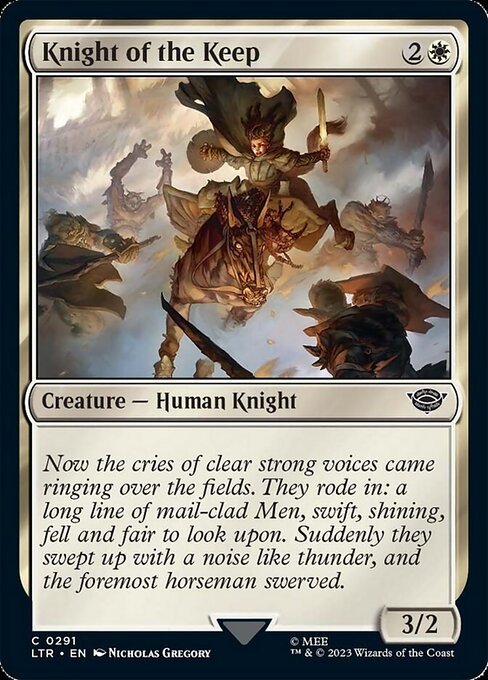 . Everything else has an activated ability, an enters-the-battlefield trigger, or an Adventure attached to it.
. Everything else has an activated ability, an enters-the-battlefield trigger, or an Adventure attached to it.
On top of the new mechanics that are introduced, there are many uneven power/toughness values, favoring toughness, so the ground will gum up pretty quickly. Because of this, we place an emphasis on the importance of combat tricks and equipment to consistently get your creatures through combat. At common and uncommon, there are almost as many creatures with greater toughness than power as there are equal p/t values (37 vs 41) and 28 creatures with higher power than toughness. That generally holds true at rare and mythic, but the number of balanced p/t creatures goes up. 3 toughness is a huge breakpoint in this set. Out of the 142 creatures in Eldraine, 106 of them have 3 toughness, and 115 have less than 4 power. That means that anything you have with 4 or more toughness is going to reliably block for most of the game (meaning Crashing Drawbridge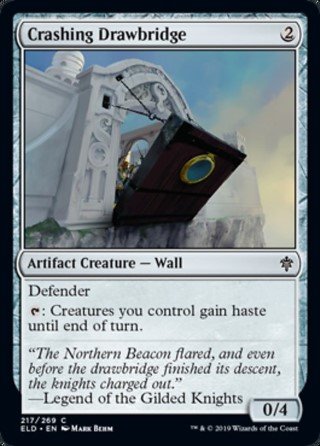 is going to be a real boon for defensive decks, and really, really annoying for aggro players).
is going to be a real boon for defensive decks, and really, really annoying for aggro players).
The common equipment cycle in this set will usually help your creatures get through this toughness hurdle, but some equipment can enable useful synergies as well.
Another layer of complication are the mechanics that Eldraine introduces. Adventure, which allows you to cast a creature spell or send it on an Adventure then cast the creature later, are pretty straightforwardly awesome: they give you the ability to cast a spell and a creature while only taking up a single card slot in your deck, which is a ton of value. Food tokens can make combat math a bit strange if your opponent has the 2 mana available to gain 3 life, and anything that eats those tokens for value can run away with the game if you let it. But when it comes to deck construction, Adamant can cause you to misevaluate your land base or the Adamant spells you’re planning to cast.
Adamant is an ability that triggers if you spend three of a certain color of mana to cast a spell. The thing about Adamant spells is that they’re already fairly costed for what they do, but if you can sink the right mana into them, you get a pretty good bonus. If you can’t, though, you’re still getting a fair amount of value from the initial cast. But Adamant acts as a deckbuilding hint in Eldraine: Eldraine wants you to commit to a certain color more than another when you build your deck. Your limited deck is likely going to be two colors, whether you’re playing draft or sealed, but you are less likely to trigger Adamant on or near curve if your land base is evenly split.
To consistently cast any of the 3-drop Adamant spells on curve, you would need 16 lands of that spell’s color in your deck. With there being no duals in Eldraine (there is one tri-land at uncommon for casting Knights), that is practically your entire mana base. It’s an unreasonable assumption, since you won’t always have an Adamant spell by turn 3 or the spell may cost 5 mana, so to have greater than a 50% chance to trigger Adamant on curve, your deck needs to have 11 sources of your Adamant color. As the cost of the Adamant spell goes up, this number goes down; if you are only adamant about casting Garenbrig Paladin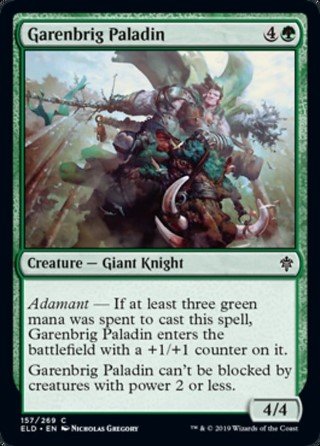 , for example, then the number goes down to 8 sources, which is closer to a limited deck from previous formats. Since most of the Adamant spells have a CMC of 4 or greater, we recommend having 10-12 sources of your primarily Adamant color in your deck if you want to reliably trigger Adamant. Otherwise, treat it as a nice occasional bonus. Here is a list of all the Adamant spells in Eldraine for you to check out.
, for example, then the number goes down to 8 sources, which is closer to a limited deck from previous formats. Since most of the Adamant spells have a CMC of 4 or greater, we recommend having 10-12 sources of your primarily Adamant color in your deck if you want to reliably trigger Adamant. Otherwise, treat it as a nice occasional bonus. Here is a list of all the Adamant spells in Eldraine for you to check out.
INTERACTION
When we did our M20 review, we only looked at common removal. However, because there are so many creatures that you will need to deal with, we wanted to evaluate the uncommon, rare, and mythic removal as well. Additionally, because there are many creatures with higher toughness than power, combat tricks will play the part of removal spells in your deck more often than not, so we will be covering those this time around. As these are discussed, please keep in mind that you will likely see ~2 copies of a common in any given draft, and ~0.5 in any sealed pool. For uncommon spells, the ratio is ~0.9 in a draft and ~0.23 in a sealed pool. So don’t expect to see these everywhere, but if you have them, appreciate their value.
WHITE INTERACTION
White is tied with blue for the least removal spells in the set at common and uncommon, though it has more tricks than the others to make up for it, as you have Outflank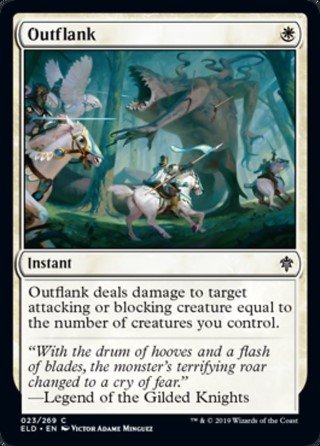 at instant speed, which gets better with more creatures. Note that it checks upon resolution, so if your opponent has instant-speed removal for one of your creatures, it may not do enough. Also at common, we have Trapped in the Tower
at instant speed, which gets better with more creatures. Note that it checks upon resolution, so if your opponent has instant-speed removal for one of your creatures, it may not do enough. Also at common, we have Trapped in the Tower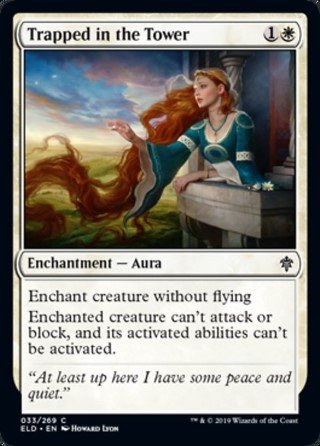 , which hits all but 27 creatures in Eldraine (29, depending on if the conditions are met for Flutterfox
, which hits all but 27 creatures in Eldraine (29, depending on if the conditions are met for Flutterfox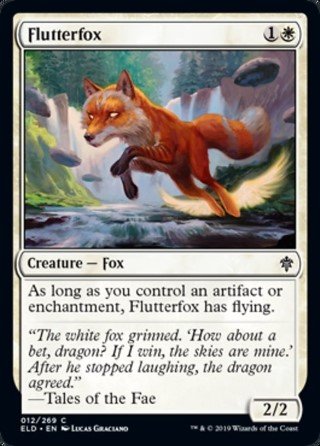 or Reaper of Night
or Reaper of Night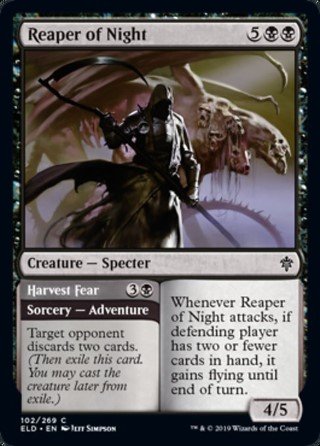 ), and if your opponent is in white, they could have a Faerie Guidemother
), and if your opponent is in white, they could have a Faerie Guidemother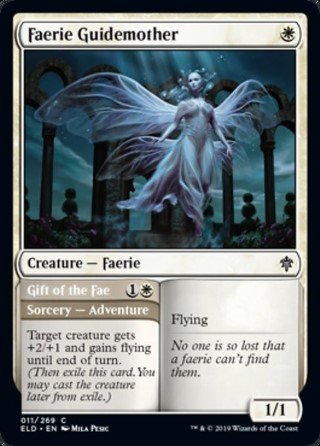 to get their creature out of the tower. At uncommon, we have Glass Casket
to get their creature out of the tower. At uncommon, we have Glass Casket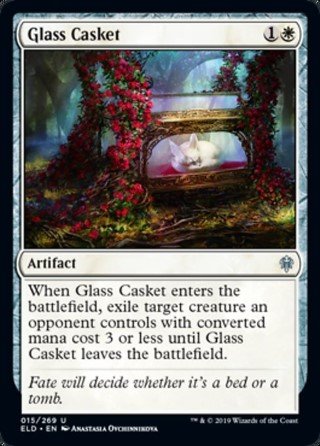 , which hits 87 creatures. Also, White has True Love’s Kiss, which seems situational but will likely come in handy for one of the 60 artifacts or enchantments in the set.
, which hits 87 creatures. Also, White has True Love’s Kiss, which seems situational but will likely come in handy for one of the 60 artifacts or enchantments in the set.
For white’s tricks, if you have a knight, you can flash in Shining Armor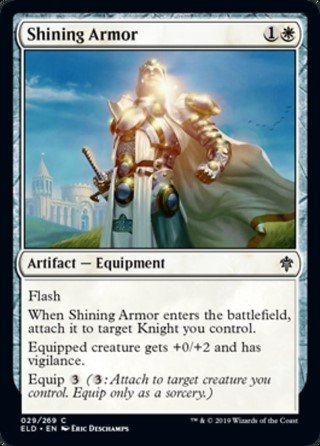 to save it in combat or from a damage-based removal spell. You also have access to On Alert
to save it in combat or from a damage-based removal spell. You also have access to On Alert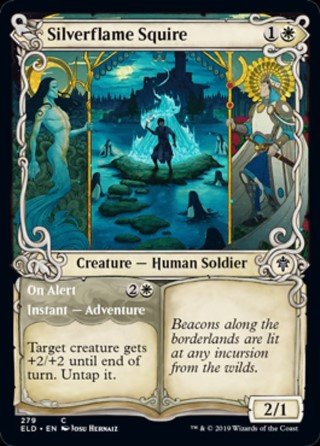 to untap a creature and pump it, or if you really want to make sure your blocker survives, you can hit it with Righteousness
to untap a creature and pump it, or if you really want to make sure your blocker survives, you can hit it with Righteousness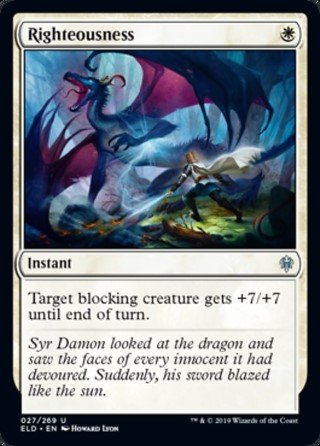 . Finally, Dizzying Swoop
. Finally, Dizzying Swoop can fog your opponent for a turn or get your creatures in.
can fog your opponent for a turn or get your creatures in.
At rare, you might run into Chop Down , which can really ruin your game plan, as the Giant Killer
, which can really ruin your game plan, as the Giant Killer can keep whichever threat that doesn’t get chopped down. White also has the mythic Cast Off
can keep whichever threat that doesn’t get chopped down. White also has the mythic Cast Off , which can destroy all non-Giants and Realm Giant comes down as a 7/7 Vigilance within a turn or two.
, which can destroy all non-Giants and Realm Giant comes down as a 7/7 Vigilance within a turn or two.
BLUE INTERACTION
Blue has the least removal spells overall, but it makes up for it with its ability to counter other spells. Charmed Sleep will efficiently deal with a threat but note that there are a few activated abilities in the set that don’t require tapping to activate. Frogify
will efficiently deal with a threat but note that there are a few activated abilities in the set that don’t require tapping to activate. Frogify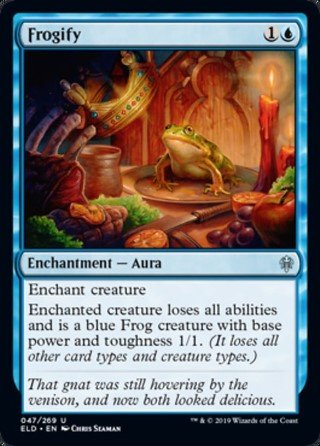 and So Tiny
and So Tiny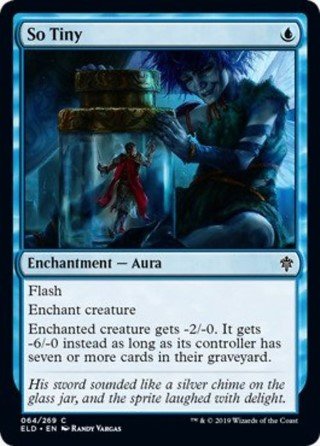 will make creatures more manageable, though the former is only at sorcery speed. Turn into a Pumpkin
will make creatures more manageable, though the former is only at sorcery speed. Turn into a Pumpkin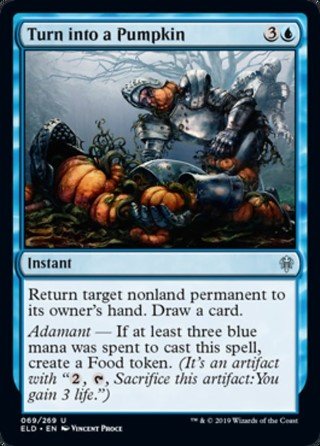 will let you bounce a creature (even your own), draw a card, and cook a Food if you spend UUU on it, Usher to Safety
will let you bounce a creature (even your own), draw a card, and cook a Food if you spend UUU on it, Usher to Safety can save your own creature, Moonlit Scavengers
can save your own creature, Moonlit Scavengers can bounce an opponent’s creature, and Run Away Together
can bounce an opponent’s creature, and Run Away Together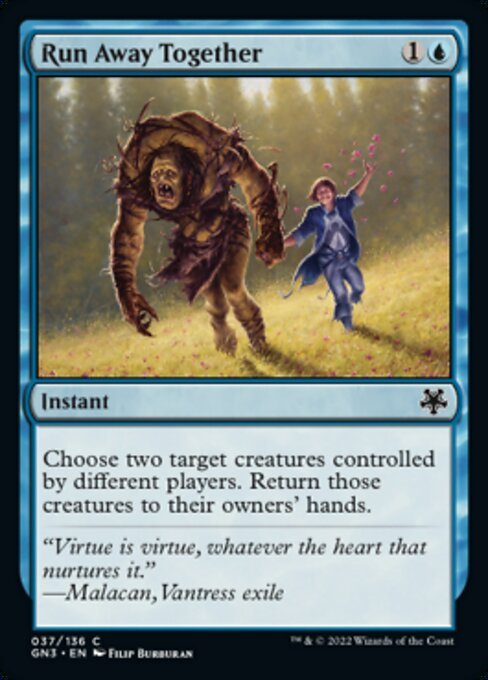 will do both. Rare and Mythic also give you access to Stolen by the Fae
will do both. Rare and Mythic also give you access to Stolen by the Fae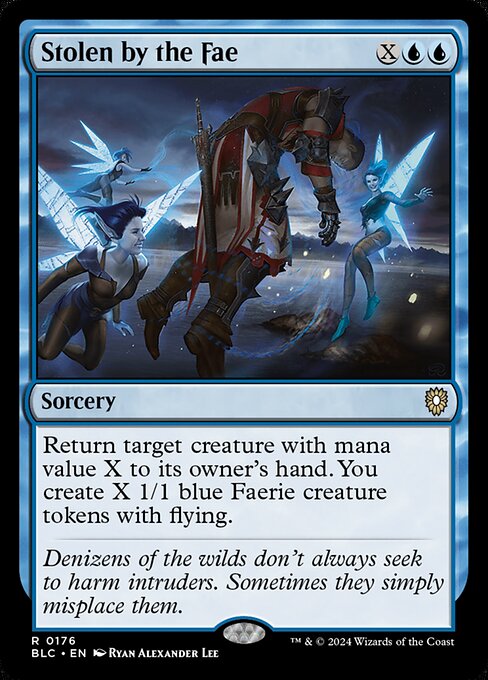 , which creates 1/1 Flying Faerie tokens equal to the CMC of what you bounce, and Petty Theft
, which creates 1/1 Flying Faerie tokens equal to the CMC of what you bounce, and Petty Theft can bounce something and the Brazen Borrower
can bounce something and the Brazen Borrower half can present a fast clock in the air.
half can present a fast clock in the air.
To make up for its lack of removal, the set’s counters are all at common and uncommon. First, you have the usual Cancel variant in Didn’t Say Please, which also mills your opponent for 3 cards. That may not seem like a lot, but you basically just put 4 cards into your opponent’s graveyard, which matters for a few key cards in the U/B archetype and is also 10% of their deck. Next is Mesmeric Glare , which can counter over 60% of the spells in the set, including all but 5 Adventure spells, which keeps your opponent from casting the attached creature. There’s also Mystical Dispute
, which can counter over 60% of the spells in the set, including all but 5 Adventure spells, which keeps your opponent from casting the attached creature. There’s also Mystical Dispute , which is okay in most matchups but ends up being a big tempo swing if your opponent is also in blue.
, which is okay in most matchups but ends up being a big tempo swing if your opponent is also in blue.
BLACK INTERACTION
Black has some of the strongest removal, though not as many as red. Most importantly is Bake into a Pie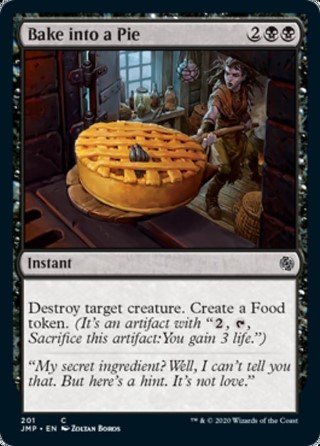 - our murder variant that also cooks up a Food token. Festive Funeral
- our murder variant that also cooks up a Food token. Festive Funeral gets better the longer the game goes on. Reave Soul
gets better the longer the game goes on. Reave Soul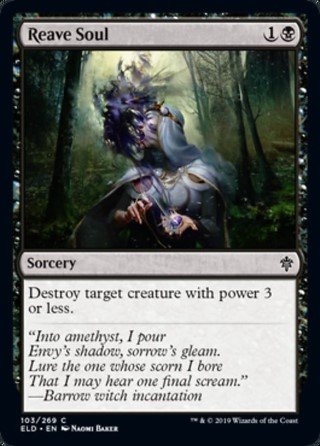 hits over 100 creatures. Epic Downfall
hits over 100 creatures. Epic Downfall will be great to deal with your opponent’s bombs, as it exiles over 50 creatures in the set. Bog Naughty
will be great to deal with your opponent’s bombs, as it exiles over 50 creatures in the set. Bog Naughty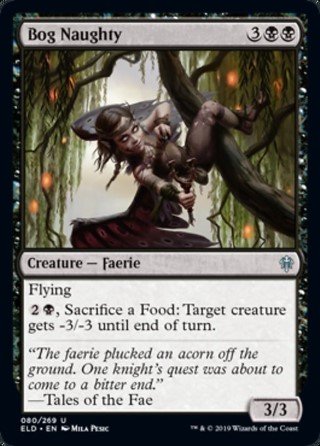 is an interesting card. It turns your Food into removal spells for over 100 creatures in the set, and is even more powerful if you activate it after combat damage. Witch’s Vengeance at rare can wipe out a tribe, and Swift End
is an interesting card. It turns your Food into removal spells for over 100 creatures in the set, and is even more powerful if you activate it after combat damage. Witch’s Vengeance at rare can wipe out a tribe, and Swift End is unconditional removal spell; while Murderous Rider
is unconditional removal spell; while Murderous Rider is theoretically able to be recurred in limited, there are only 3 shuffle effects, all of which are rare, so you are only ever likely to get hit by it once.
is theoretically able to be recurred in limited, there are only 3 shuffle effects, all of which are rare, so you are only ever likely to get hit by it once.
Black’s only trick is Lash of Thorns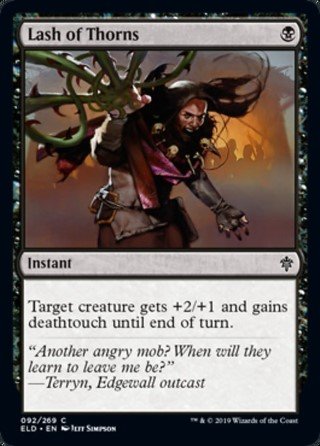 , which can pump one of your creatures and give it Deathtouch. Your creature might survive combat, but your opponent’s definitely won’t.
, which can pump one of your creatures and give it Deathtouch. Your creature might survive combat, but your opponent’s definitely won’t.
RED INTERACTION
Red’s removal spells are easily the most impressive in the set. Fling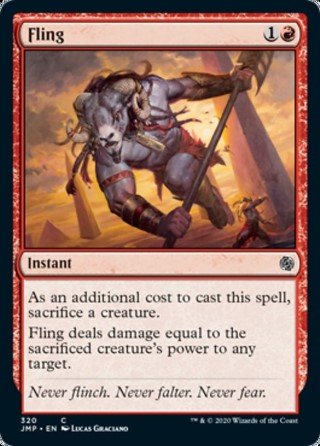 is back on the menu, so you can sacrifice a creature at instant speed to remove an opponent’s creature (or an opponent) from the battlefield (If you manage to combo this with Outflank
is back on the menu, so you can sacrifice a creature at instant speed to remove an opponent’s creature (or an opponent) from the battlefield (If you manage to combo this with Outflank , please let us know! We want to live vicariously through your victory!).
, please let us know! We want to live vicariously through your victory!).
Scorching Dragonfire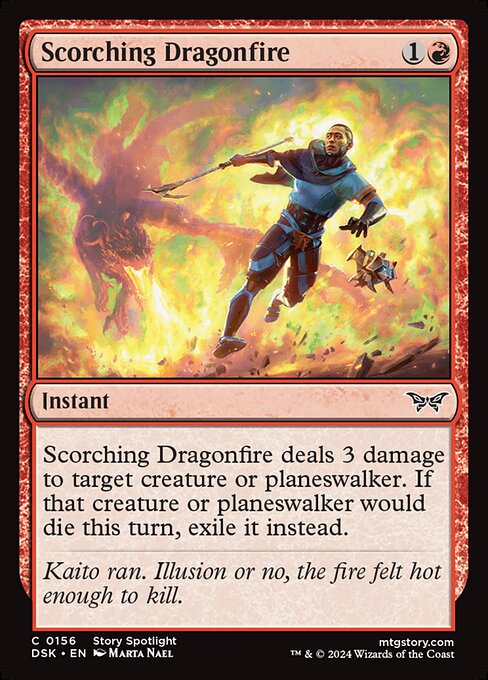 hits 100 creatures and exiles them, which could be important if your opponent is in black. Searing Barrage hits over 130 creatures and bolts your opponent if you have Adamant; it’s also splash-able on its own with only one red mana pip. Redcap Melee
hits 100 creatures and exiles them, which could be important if your opponent is in black. Searing Barrage hits over 130 creatures and bolts your opponent if you have Adamant; it’s also splash-able on its own with only one red mana pip. Redcap Melee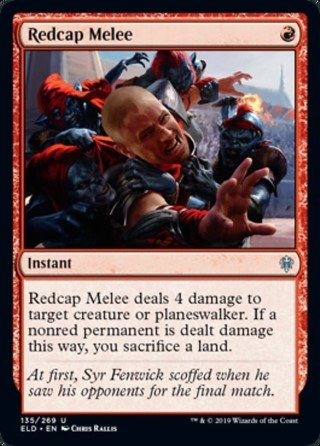 is an interesting card, as it might force you to sacrifice a land if you target a non-red creature, but hits 120 creatures, 27 of which are red. Slaying Fire
is an interesting card, as it might force you to sacrifice a land if you target a non-red creature, but hits 120 creatures, 27 of which are red. Slaying Fire is pretty versatile, as you can use it early or save it to Adamant a 4-power creature away. Battle Display
is pretty versatile, as you can use it early or save it to Adamant a 4-power creature away. Battle Display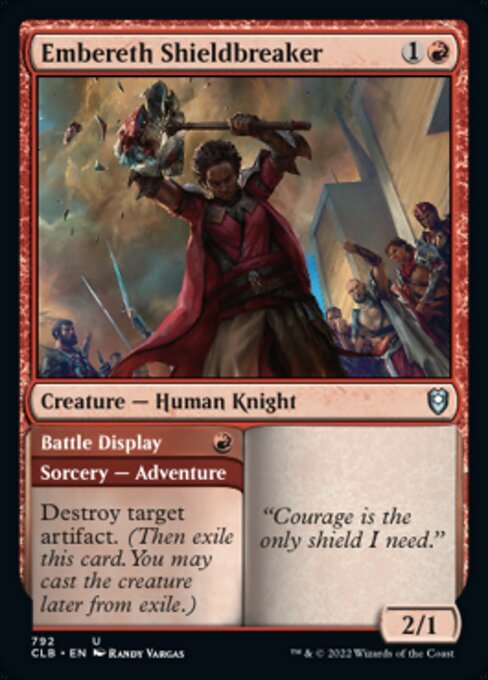 isn’t very likely to act as a removal spell, but it can kill 17 creatures in the set, and will be useful to get rid of your opponent’s equipment.
isn’t very likely to act as a removal spell, but it can kill 17 creatures in the set, and will be useful to get rid of your opponent’s equipment.
Blow Your House Down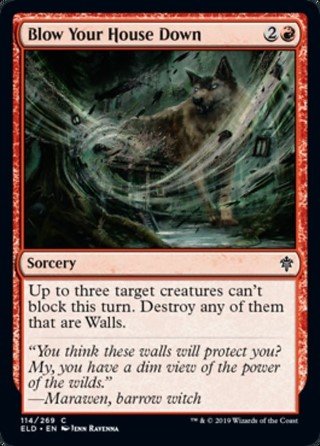 is really a trick that could work as a removal spell, since there are 3 Walls, all of which are at common. Regardless, it will likely win you some games by letting you get through a stalled board. Similarly, Barge In
is really a trick that could work as a removal spell, since there are 3 Walls, all of which are at common. Regardless, it will likely win you some games by letting you get through a stalled board. Similarly, Barge In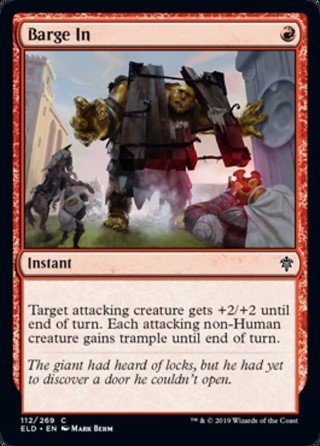 might help your creatures trample over your opponent’s blockers if you have enough non-Humans, and Boulder Rush
might help your creatures trample over your opponent’s blockers if you have enough non-Humans, and Boulder Rush is an okay pump spell. Joust
is an okay pump spell. Joust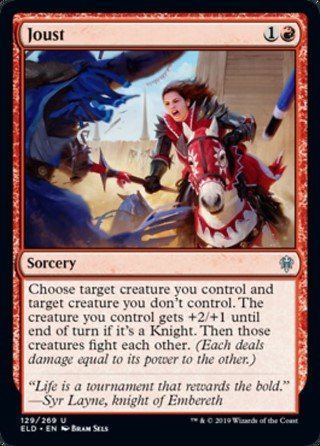 can act as a fight spell, but you get extra value if you target a knight.
can act as a fight spell, but you get extra value if you target a knight.
Red has some interesting interaction at rare. Stomp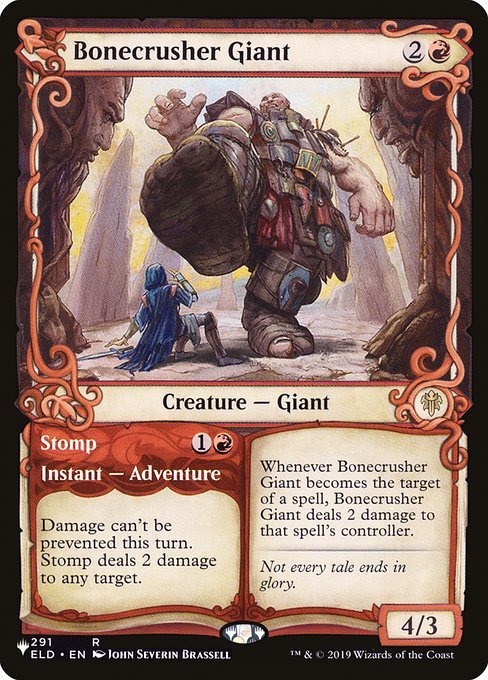 can occasionally burn your opponent for 2 and remove a creature. Irencrag Pyromancer
can occasionally burn your opponent for 2 and remove a creature. Irencrag Pyromancer can block well and, hopefully, bolt your opponent every time you draw a card. Finally,Sundering Stroke
can block well and, hopefully, bolt your opponent every time you draw a card. Finally,Sundering Stroke can end games on its own (especially if you cast it with 7 red mana).
can end games on its own (especially if you cast it with 7 red mana).
GREEN INTERACTION
Surprisingly, there isn’t a Plummet in the set, but there is Fell the Pheasant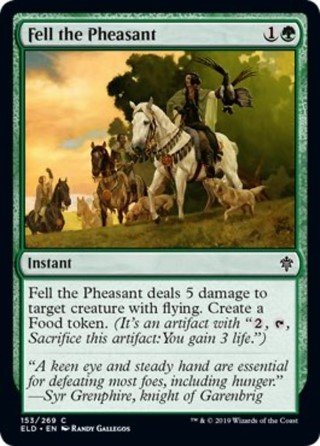 , which happens to hit every flyer. This is good, because there are only 2 creatures in the set below rare with Reach. Outmuscle
, which happens to hit every flyer. This is good, because there are only 2 creatures in the set below rare with Reach. Outmuscle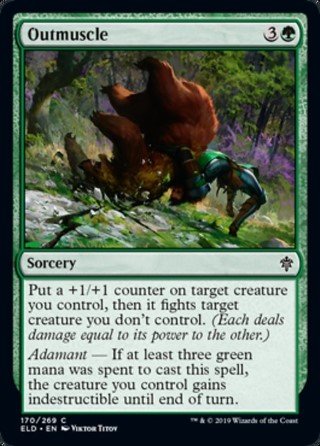 is great, especially if you can cast it with Adamant, as you’re able to freely attack in with your creature after you remove your opponent’s. Return to Nature
is great, especially if you can cast it with Adamant, as you’re able to freely attack in with your creature after you remove your opponent’s. Return to Nature is going to be important, as there are 60 artifacts and enchantments running around, as well as ways in blue and black to recur things from graveyards. Similarly, Flaxen Intruder
is going to be important, as there are 60 artifacts and enchantments running around, as well as ways in blue and black to recur things from graveyards. Similarly, Flaxen Intruder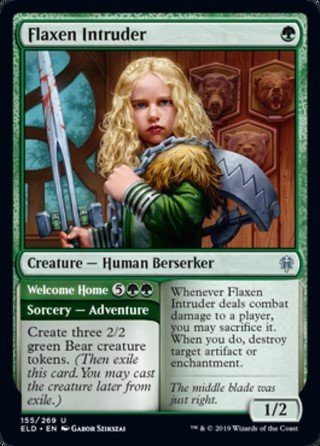 can destroy an artifact or enchantment.
can destroy an artifact or enchantment.
Kenrith’s Transformation is an interesting card. A 3/3 is kind of tough to deal with, though it can get rid of a dangerous activated ability. You can also put it on one of your own creatures, if it was an early drop. Plus, it draws you a card.
Green has two pump spells: Shield’s Might and Insatiable Appetite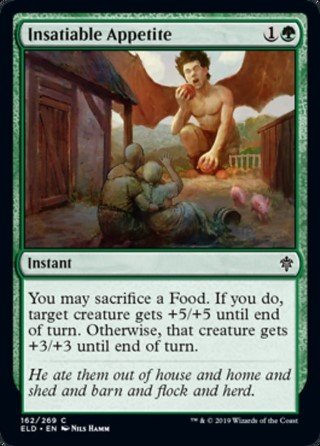 , the latter of which could close out a game if you have a spare Food lying around.
, the latter of which could close out a game if you have a spare Food lying around.
Finally, at rare, Wicked Wolf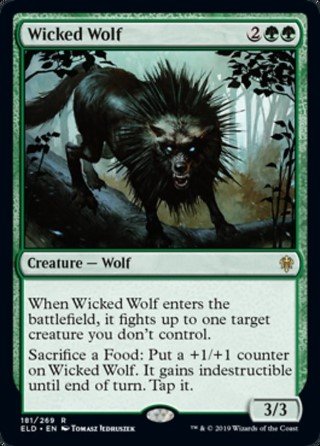 is able to fight a creature, grow itself, and make itself indestructible if you feed it well.
is able to fight a creature, grow itself, and make itself indestructible if you feed it well.
COLORLESS/MULTICOLOR INTERACTION
Spinning Wheel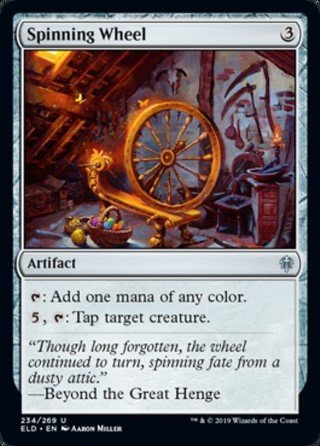 can ramp you or tap down a creature late game, and Scalding Cauldron
can ramp you or tap down a creature late game, and Scalding Cauldron serves the same role that Vial of Dragonfire
serves the same role that Vial of Dragonfire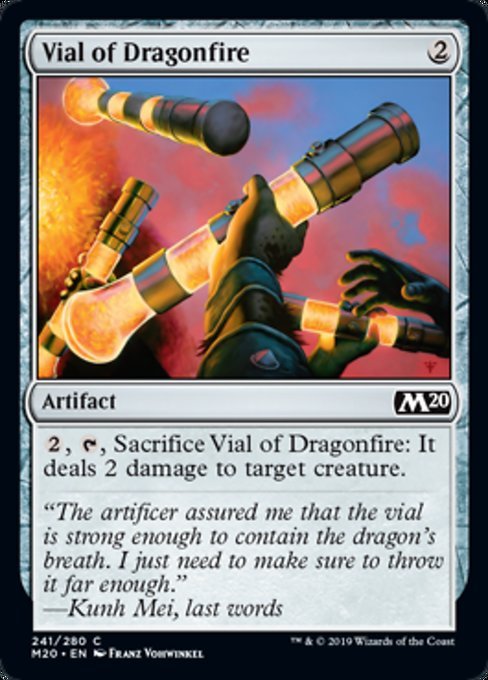 did in M20 as a decent removal spell you can pay for over time. U/B has Drown in the Loch
did in M20 as a decent removal spell you can pay for over time. U/B has Drown in the Loch , which serves as either a counter or a removal spell and gets better as the game goes on.
, which serves as either a counter or a removal spell and gets better as the game goes on.
At the higher rarities, there is Doom Foretold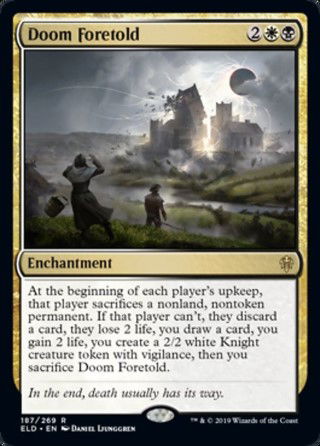 , which should work well if you are able to keep your opponent off balance. Otherwise, you will just eventually sacrifice your own Doom Foretold to itself and not get much value from it, though depending on the game state, it might make sense just to force your opponent to sac some things.
, which should work well if you are able to keep your opponent off balance. Otherwise, you will just eventually sacrifice your own Doom Foretold to itself and not get much value from it, though depending on the game state, it might make sense just to force your opponent to sac some things.
Mythic brings us the Planeswalkers. Garruk, Cursed Huntsman can destroy a creature while drawing himself a card. Oko, Thief of Crowns
can destroy a creature while drawing himself a card. Oko, Thief of Crowns can either swap one of your food tokens for an opponent’s creature or turn an artifact or creature into a 3/3 Elk (which, as discussed earlier, can be either a removal spell for an opponent’s creature or an upgrade for your own). Finally, The Royal Scions
can either swap one of your food tokens for an opponent’s creature or turn an artifact or creature into a 3/3 Elk (which, as discussed earlier, can be either a removal spell for an opponent’s creature or an upgrade for your own). Finally, The Royal Scions can pump a creature and give it First Strike and Trample, and their ultimate can hit something for at least 4.
can pump a creature and give it First Strike and Trample, and their ultimate can hit something for at least 4.
LIMITED ARCHETYPES
Before we move on to each of the Limited archetypes, we are going to take a second look at the mechanics in the set. All the mechanics exist in all colors, which means that even if you don’t have all the right cards for the B/G food deck, you can generate food in other colors to supplement the Green Food value engines you have. The same is true for Adventures, drawing multiple cards, or the Knights-creature type, whose cards are usually powerful enough that you’ll want to run them if they’re in your colors anyway. This reinforces the “primary color/secondary color” design in Eldraine we talked about in the Adamant section, and the artifacts in the set give that an additional level of flexibility. That said, there are still two-color pairings that will drive synergistic strategies, but this flexibility will let you build a deck that has at least some sort of synergy regardless of what two colors you are playing. Focus on building around strong removal and strong creatures first, and then look at what synergies you can enable based on the below pairings. Also keep in mind the creatures that we call out in each pairing are likely going to be big removal targets (for your opponent if you have them, and for you if your opponent has them).
KNIGHTS
Okay, before we actually get into the two-color pairings, we need to talk about Knights. Knights Matter is a theme that exists in Mardu (RWB), and is supported as a 3-color tribe thanks to Tournament Grounds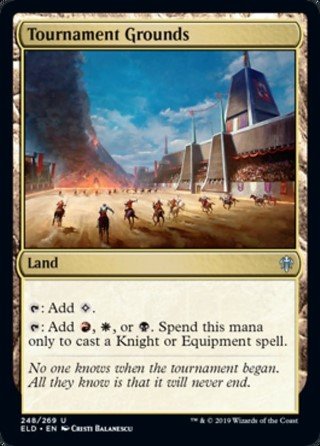 . There are 28 knights in these colors alone, and the strategy is to aggressively go wide with efficient creatures and the bevy of splashable removal those 3 colors get you. You’ll also want some to focus on splashable creatures (by splashable, we mean anything that has one color pip instead of two or more; this makes it more easily castable with a riskier manabase). Belle of the Brawl
. There are 28 knights in these colors alone, and the strategy is to aggressively go wide with efficient creatures and the bevy of splashable removal those 3 colors get you. You’ll also want some to focus on splashable creatures (by splashable, we mean anything that has one color pip instead of two or more; this makes it more easily castable with a riskier manabase). Belle of the Brawl can pump all of your knights, Altered Fate is fantastic for recursion as well as Order of Midnight
can pump all of your knights, Altered Fate is fantastic for recursion as well as Order of Midnight being a great early game play. Youthful Knight
being a great early game play. Youthful Knight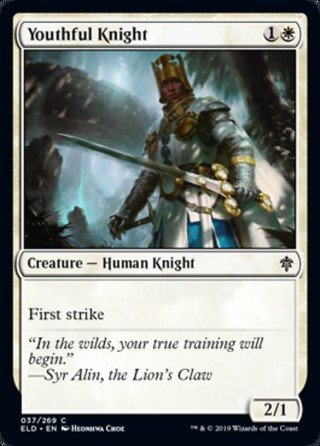 is one of the only cards with First Strike, and it lets him kill over 60 creatures. Lost Legion
is one of the only cards with First Strike, and it lets him kill over 60 creatures. Lost Legion isn’t splashable but blocks well and the Scry 2 is useful. Ogre Errant
isn’t splashable but blocks well and the Scry 2 is useful. Ogre Errant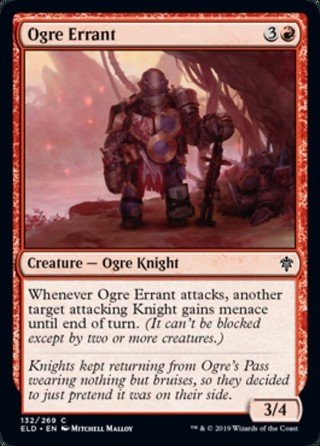 gives another creature Menace, and Jousting Dummy
gives another creature Menace, and Jousting Dummy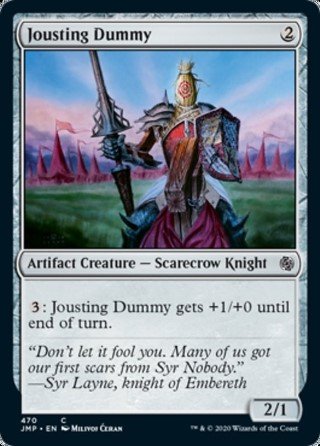 is easy to cast, though inefficient to activate.
is easy to cast, though inefficient to activate.
However, if you cannot find a Tournament Grounds , there are some uncommon signposts to guide you into different strategies that might make your deck more focused.
, there are some uncommon signposts to guide you into different strategies that might make your deck more focused.
W/B KNIGHTS
Wintermoor Commander and Resolute Rider
and Resolute Rider create environments that focus on attrition. You can easily protect your knights while efficiently removing your opponent’s creatures. Curry Favor
create environments that focus on attrition. You can easily protect your knights while efficiently removing your opponent’s creatures. Curry Favor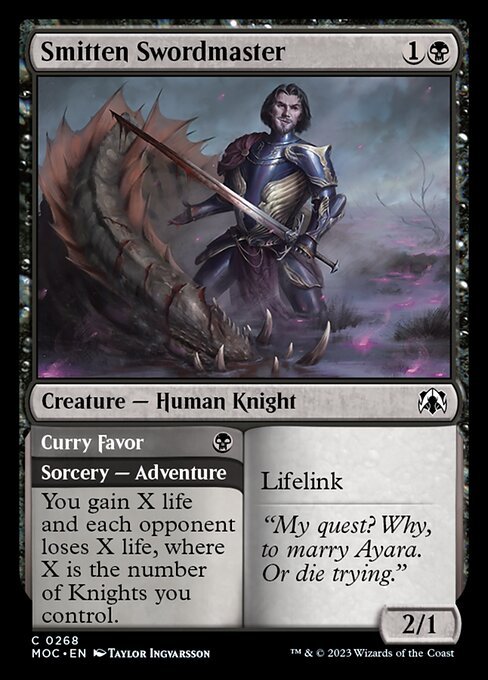 is good for getting in some extra points of damage if the board stalls, Barrow Witches
is good for getting in some extra points of damage if the board stalls, Barrow Witches can bring back a creature, and Syr Konrad, the Grim
can bring back a creature, and Syr Konrad, the Grim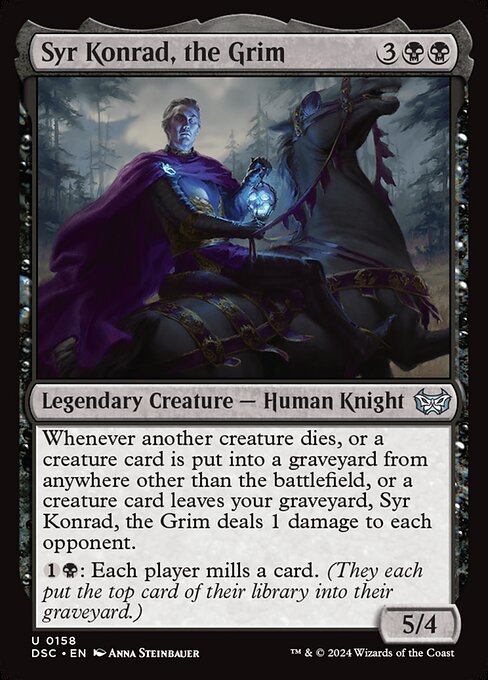 is extremely useful for capitalizing on your creature’s deaths. Bonus points if you can burn your opponent out with Forever Young
is extremely useful for capitalizing on your creature’s deaths. Bonus points if you can burn your opponent out with Forever Young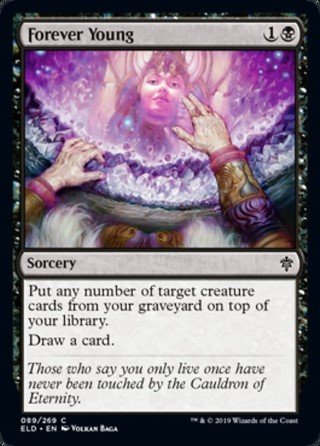 .
.
R/W KNIGHTS
Inspiring Veteran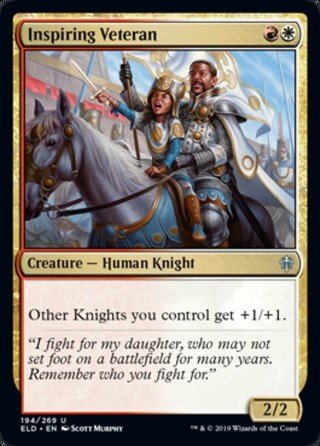 and Fireborn Knight
and Fireborn Knight want you to go wide. You will have a lot of cheap knights in here that can deal some extra damage through Haste (Burning-Yard Trainer
want you to go wide. You will have a lot of cheap knights in here that can deal some extra damage through Haste (Burning-Yard Trainer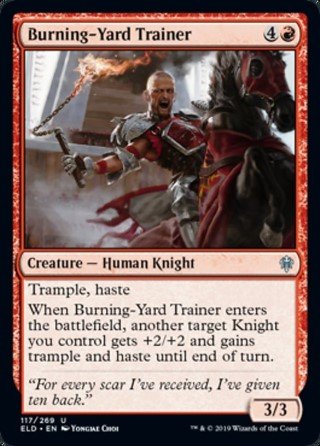 ), Menace (Ogre Errant
), Menace (Ogre Errant ), Double Strike (Raging Redcap
), Double Strike (Raging Redcap ), or getting a few activations off of a Weaselback Redcap
), or getting a few activations off of a Weaselback Redcap . Dizzying Swoop
. Dizzying Swoop is going to be great to make sure your creatures get in and Ardenvale Tactician
is going to be great to make sure your creatures get in and Ardenvale Tactician can cause some damage in the air. Keep an eye out for Gleaming Armor to give your creatures Vigilance, Crystal Slipper
can cause some damage in the air. Keep an eye out for Gleaming Armor to give your creatures Vigilance, Crystal Slipper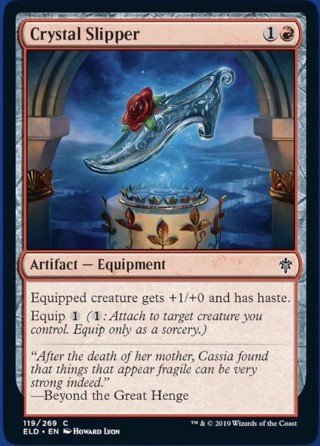 to give a creature Haste, or Silverflame Ritual
to give a creature Haste, or Silverflame Ritual to put your creatures out of your opponent’s reach.
to put your creatures out of your opponent’s reach.
B/R KNIGHTS
Steelclaw Lance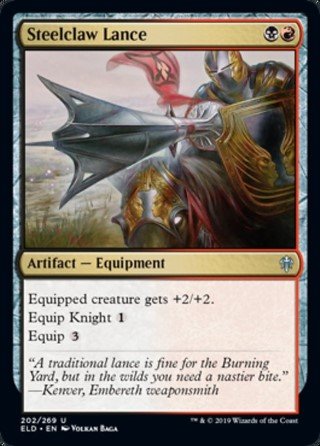 and Elite Headhunter
and Elite Headhunter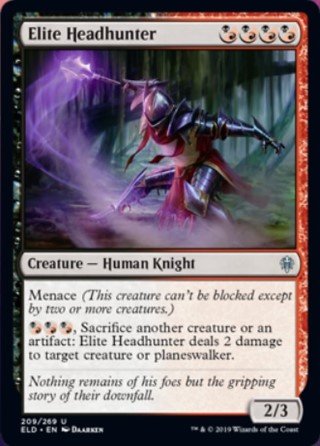 make sure your creatures can deal damage. Headhunter synergizes with artifacts and Food tokens as well. Use your removal and the previously mentioned useful knights in both colors and you’ll likely end games quickly.
make sure your creatures can deal damage. Headhunter synergizes with artifacts and Food tokens as well. Use your removal and the previously mentioned useful knights in both colors and you’ll likely end games quickly.
W/U ENCHANTMENTS AND ARTIFACTS
Shinechaser and Arcanist’s Owl make it glaringly obvious that you will want to prioritize artifacts and enchantments for this build. While there are some fun creatures for this (like Queen of Ice
and Arcanist’s Owl make it glaringly obvious that you will want to prioritize artifacts and enchantments for this build. While there are some fun creatures for this (like Queen of Ice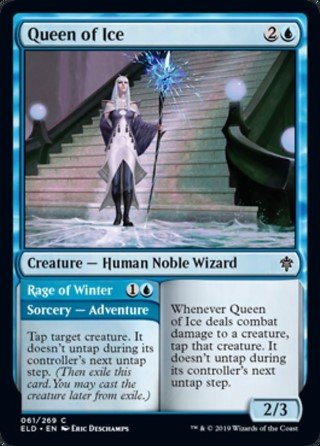 ), you will mostly want to focus on flyers. Mysterious Pathlighter
), you will mostly want to focus on flyers. Mysterious Pathlighter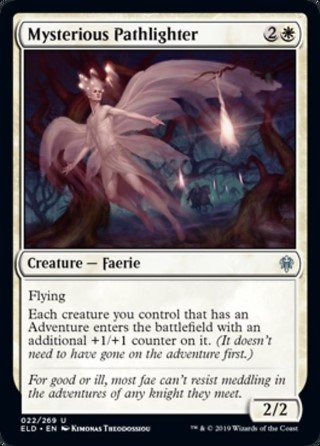 , Animating Faerie
, Animating Faerie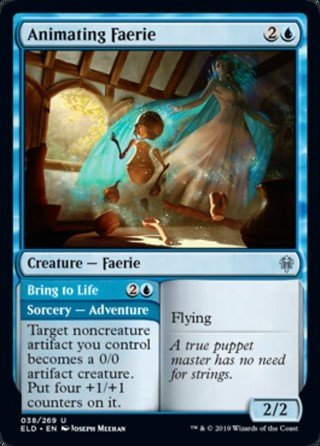 , Faerie Guidemother
, Faerie Guidemother , and our friend the Ardenvale Tactician
, and our friend the Ardenvale Tactician is extremely useful. Flutterfox
is extremely useful. Flutterfox , Shambling Suit
, Shambling Suit , and All That Glitters
, and All That Glitters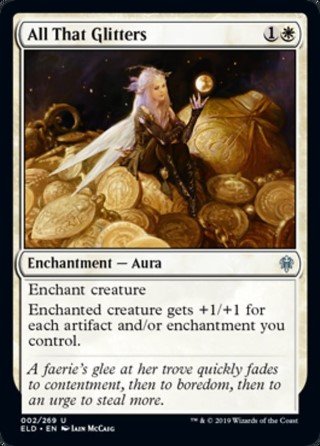 care about artifacts and enchantments (which, if you noticed earlier, are primarily how white and blue get their removal in this set). Crashing Drawbridge
care about artifacts and enchantments (which, if you noticed earlier, are primarily how white and blue get their removal in this set). Crashing Drawbridge can defend you on the ground and give your flyers Haste, and Fortifying Provisions
can defend you on the ground and give your flyers Haste, and Fortifying Provisions immediately enables both modes of Shinechaser and makes combat math awful for your opponent.
immediately enables both modes of Shinechaser and makes combat math awful for your opponent.
U/B MILL
Drown in the Loch can act as a fantastic removal spell, while Covetous Urge
can act as a fantastic removal spell, while Covetous Urge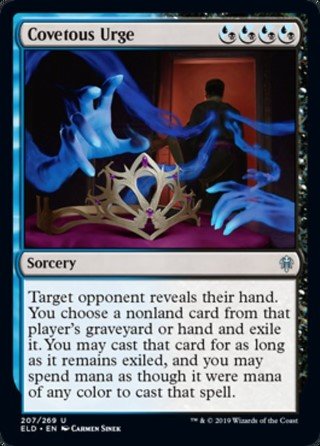 can steal your opponent’s best card. Venture Deeper
can steal your opponent’s best card. Venture Deeper mills your opponent and Merfolk Secretkeeper
mills your opponent and Merfolk Secretkeeper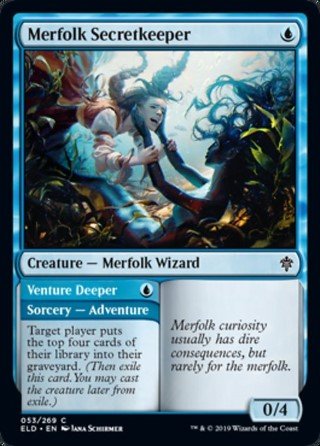 puts a really big butt on the ground, Overwhelmed Apprentice
puts a really big butt on the ground, Overwhelmed Apprentice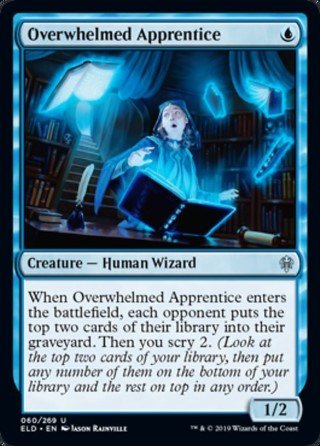 is the best Fugitive Wizard ever printed, Reaper of the Night is almost always a flyer, as your opponent isn’t likely to have two cards in hand at the end of the game. This is where you want your removal spells and counters to fuel Drown in the Loch
is the best Fugitive Wizard ever printed, Reaper of the Night is almost always a flyer, as your opponent isn’t likely to have two cards in hand at the end of the game. This is where you want your removal spells and counters to fuel Drown in the Loch , as well as Syr Konrad, the Grim
, as well as Syr Konrad, the Grim for his activated milling ability.
for his activated milling ability.
R/G NON-HUMANS
Grumgully, the Generous makes your non-humans bigger, and thus tougher to deal with, and Rampart Smasher
makes your non-humans bigger, and thus tougher to deal with, and Rampart Smasher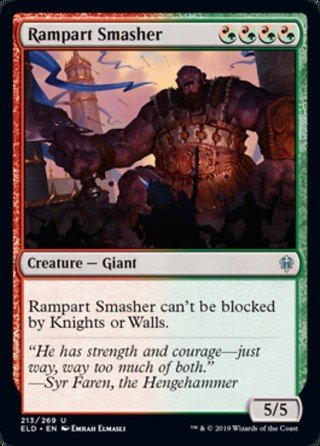 is likely a free 5 damage against certain decks. At common and uncommon, there are 23 non-human creatures, some of which are knights that we mentioned earlier, but others care about non-creatures too. Redcap Raiders
is likely a free 5 damage against certain decks. At common and uncommon, there are 23 non-human creatures, some of which are knights that we mentioned earlier, but others care about non-creatures too. Redcap Raiders and Wildwood Tracker
and Wildwood Tracker![]() pump themselves, Keeper of Fables
pump themselves, Keeper of Fables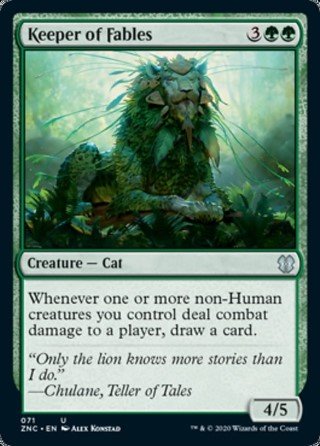 will draw cards, and Fierce Witchstalker
will draw cards, and Fierce Witchstalker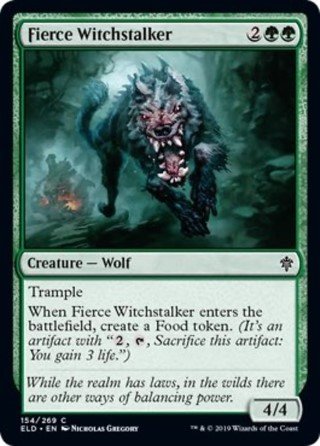 is probably the best green common in the set. Barge In
is probably the best green common in the set. Barge In is built for this deck, Ferocity of the Wilds
is built for this deck, Ferocity of the Wilds can pump your creatures, and Rosethorn Halberd
can pump your creatures, and Rosethorn Halberd is a free equip if you sequence things right.
is a free equip if you sequence things right.
G/W ADVENTURES
Wandermare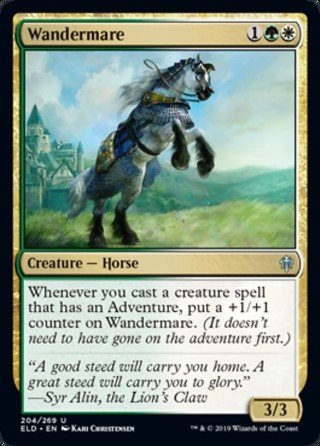 wants you to fill your deck with Adventures. Oakhame Ranger
wants you to fill your deck with Adventures. Oakhame Ranger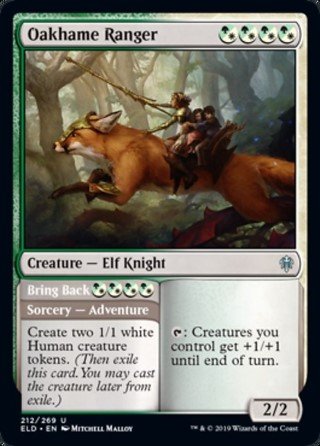 is an Adventure itself and can also pump your team. Mysterious Pathlighter
is an Adventure itself and can also pump your team. Mysterious Pathlighter will grow those creatures, Edgewall Inkeeper will draw you cards, Garenbrig Squire
will grow those creatures, Edgewall Inkeeper will draw you cards, Garenbrig Squire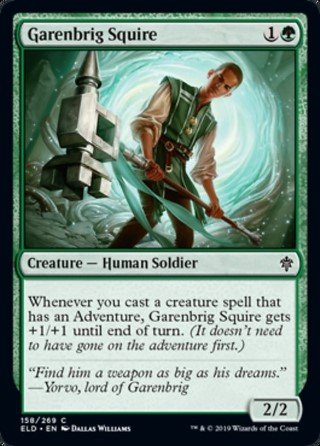 will get swole for a turn; note that you don’t have to cast the Adventure first for these cards and Wandermare
will get swole for a turn; note that you don’t have to cast the Adventure first for these cards and Wandermare to trigger, so you can still play your creatures on curve. Beanstalk Giant
to trigger, so you can still play your creatures on curve. Beanstalk Giant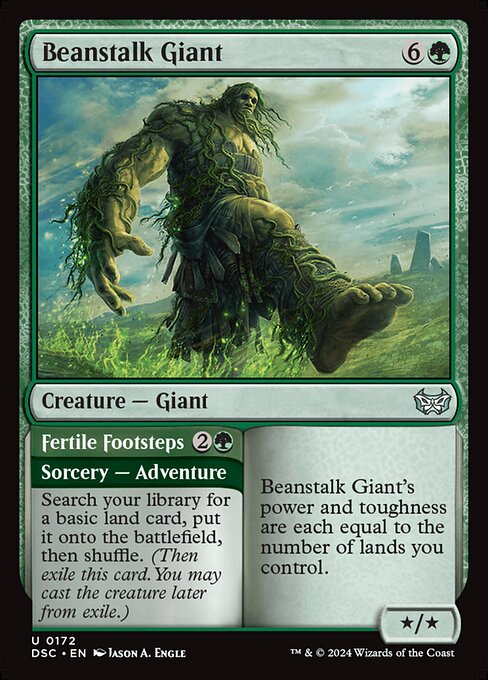 feeds itself, or you can use Tall as a Beanstalk
feeds itself, or you can use Tall as a Beanstalk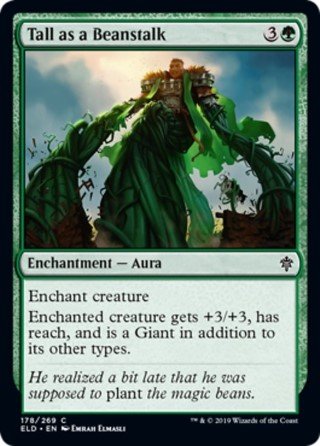 to make one of your creatures (ideally a flyer) really big, and if you’re really fortunate, Lucky Clover
to make one of your creatures (ideally a flyer) really big, and if you’re really fortunate, Lucky Clover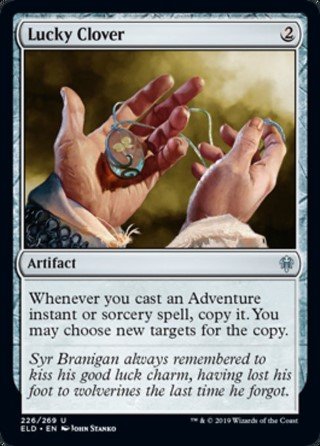 will copy your Adventure spells.
will copy your Adventure spells.
U/R DRAW
This is the archetype that Chris and Lu are both most excited about. Improbable Alliance rewards you with tokens for drawing cards (and gives you the ability to draw them), and Loch Dragon
rewards you with tokens for drawing cards (and gives you the ability to draw them), and Loch Dragon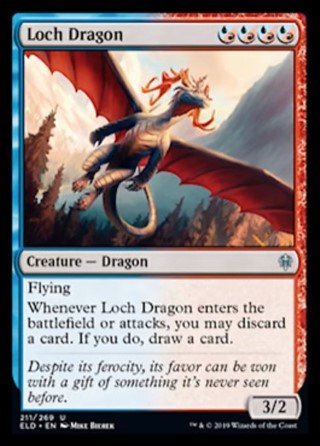 is a great enabler for this strategy. Faerie Vandall permanently buffs itself, while Steelgaze Griffin
is a great enabler for this strategy. Faerie Vandall permanently buffs itself, while Steelgaze Griffin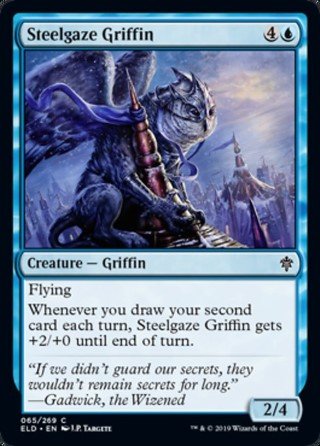 and Bloodhaze Wolverine
and Bloodhaze Wolverine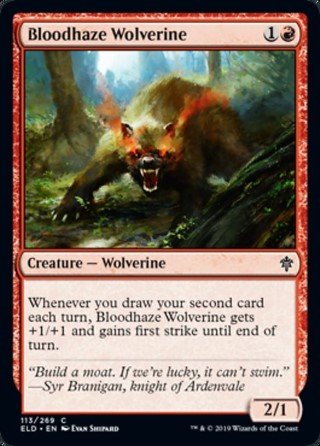 each get temporary (but powerful) buffs. Mad Ratter
each get temporary (but powerful) buffs. Mad Ratter will make tokens, while Mantle of Tides
will make tokens, while Mantle of Tides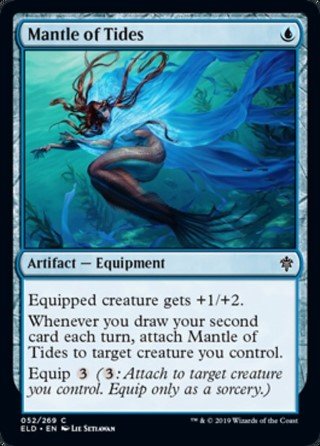 is a cheap stat boost with a potentially free equip. Thrill of Possibility
is a cheap stat boost with a potentially free equip. Thrill of Possibility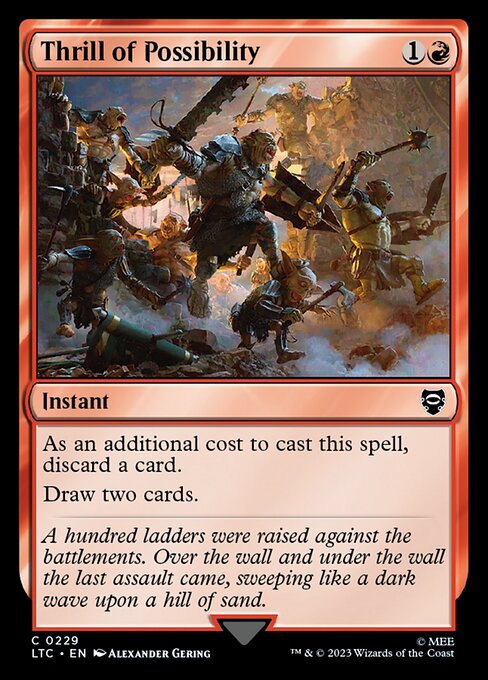 or Merchant of the Vale
or Merchant of the Vale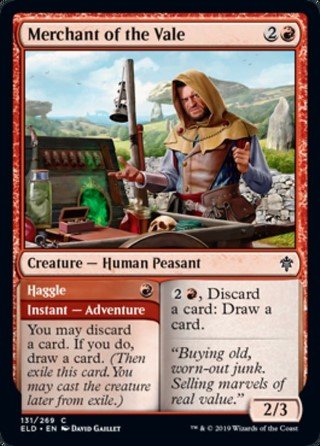 will let you draw two cards on your opponent’s turn, Tome Raider
will let you draw two cards on your opponent’s turn, Tome Raider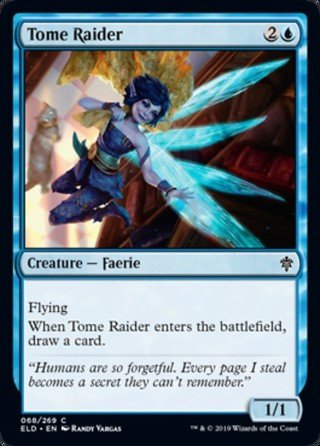 and Syr Elenora, the Discerning
and Syr Elenora, the Discerning draw when they enter, and Clockwork Servant
draw when they enter, and Clockwork Servant can get you a card with Adamant. Since most of these creatures aren’t human, Sage of the Falls
can get you a card with Adamant. Since most of these creatures aren’t human, Sage of the Falls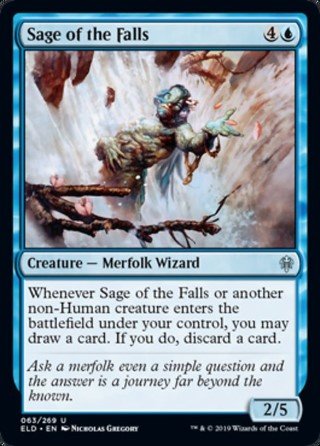 will almost always get you a second card. Opt
will almost always get you a second card. Opt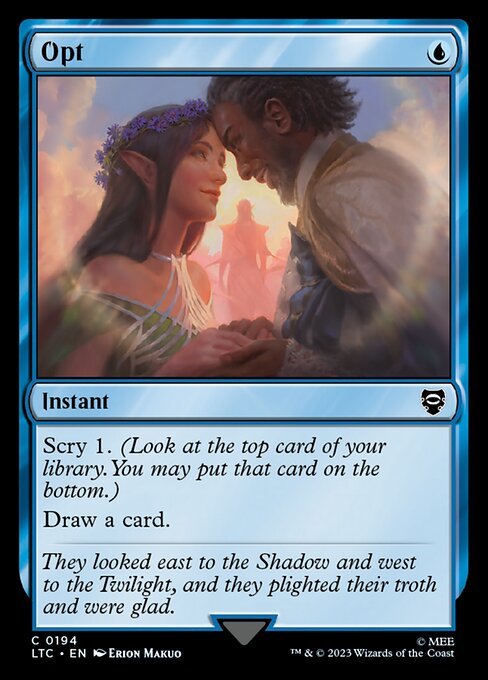 , Turn into a Pumpkin
, Turn into a Pumpkin , Unexplained Visions, and Witching Well
, Unexplained Visions, and Witching Well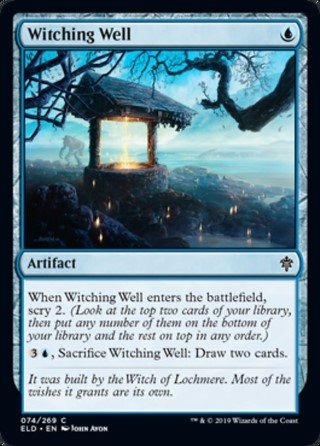 are going to be really useful, as well as any removal or counterspells you can fit in.
are going to be really useful, as well as any removal or counterspells you can fit in.
B/G FOOD
Black-Green cares all about food and food accessories. Savvy Hunter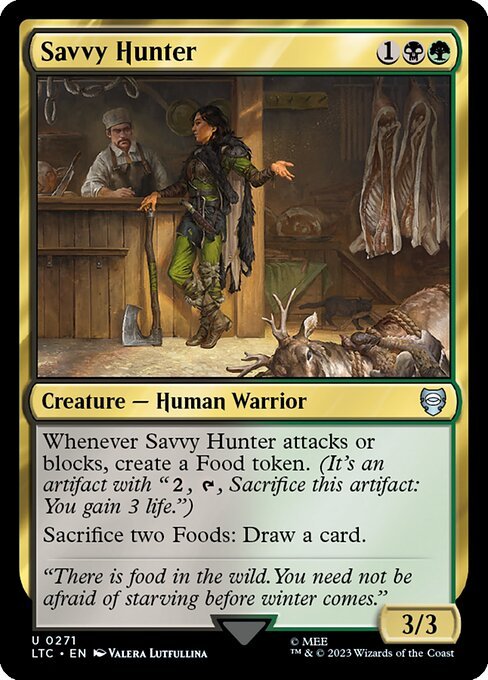 will run away with food production if your opponent can’t deal with it, and it can draw you two cards, while you can infinitely recur Deathless Knight
will run away with food production if your opponent can’t deal with it, and it can draw you two cards, while you can infinitely recur Deathless Knight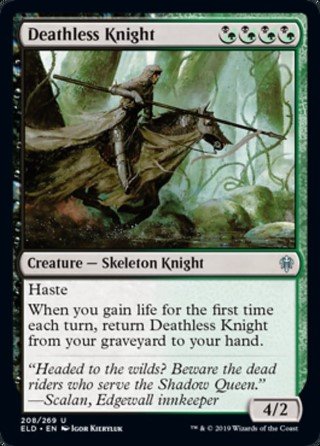 by eating your Food or dropping Revenge of Ravens
by eating your Food or dropping Revenge of Ravens . Trail of Crumbs
. Trail of Crumbs will draw you cards, Giant’s Skewer will pump your creature and generate food (or, likely, keep your opponent from attacking). Fierce Witchstalker
will draw you cards, Giant’s Skewer will pump your creature and generate food (or, likely, keep your opponent from attacking). Fierce Witchstalker shines in this deck, as well as Maraleaf Rider
shines in this deck, as well as Maraleaf Rider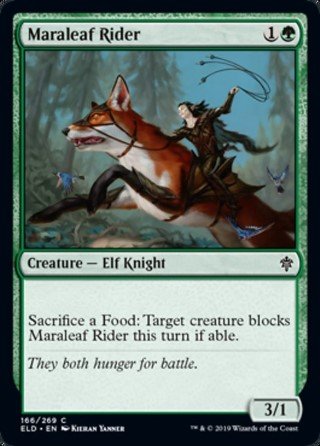 , which can act as either a removal spell or forcibly cook if you give it the Giant’s Skewer. Tempting Witch
, which can act as either a removal spell or forcibly cook if you give it the Giant’s Skewer. Tempting Witch can eat your food and make your opponents pay for it, Bog Naughty
can eat your food and make your opponents pay for it, Bog Naughty turns Food into removal spells, and Giant Opportunity
turns Food into removal spells, and Giant Opportunity turns them into a 7/7. You’ll also want to keep an eye out for Food artifacts like the Golden Egg
turns them into a 7/7. You’ll also want to keep an eye out for Food artifacts like the Golden Egg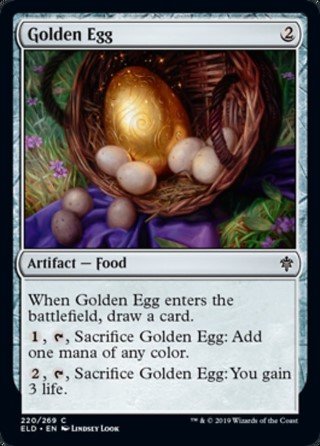 or Gingerbrute
or Gingerbrute , as well as Witch’s Oven. If you’re lucky enough and the game goes on long enough, you can generate Food every turn with Witch’s Oven and Sorcerer’s Broom. Be sure to pick up as much removal in black as you can, as well ways to manage flyers (Sporecap Spider
, as well as Witch’s Oven. If you’re lucky enough and the game goes on long enough, you can generate Food every turn with Witch’s Oven and Sorcerer’s Broom. Be sure to pick up as much removal in black as you can, as well ways to manage flyers (Sporecap Spider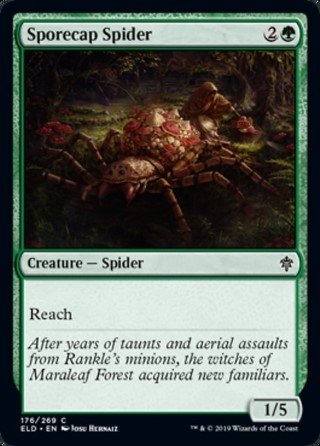 , Fell the Pheasant
, Fell the Pheasant ).
).
U/G BIG STUFF
We mention in the video that this sort of feels like a catch-all archetype. It’s not as cohesive with synergy as the others, but it makes up for it with raw creature power. Maraleaf Pixie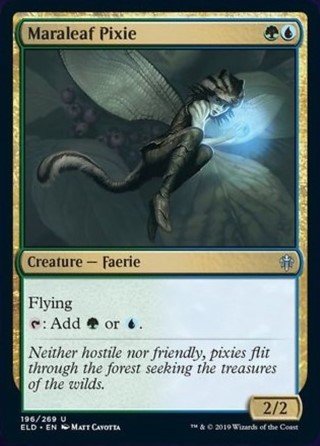 is one of the few ways to ramp yourself, and [Thunderous Snapper can reliably draw you cards while also having that crucial 4/4 body. A lot of your creatures will be non-human, like so Keeper of Tales will draw you cards and Mistford River Turtle
is one of the few ways to ramp yourself, and [Thunderous Snapper can reliably draw you cards while also having that crucial 4/4 body. A lot of your creatures will be non-human, like so Keeper of Tales will draw you cards and Mistford River Turtle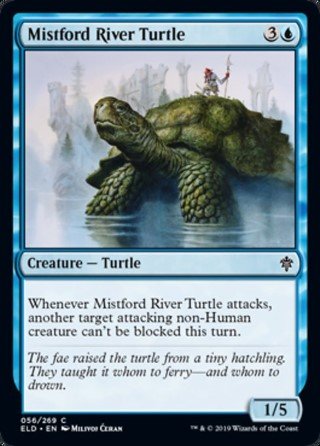 will let your big hitters get through. Fertile Footsteps
will let your big hitters get through. Fertile Footsteps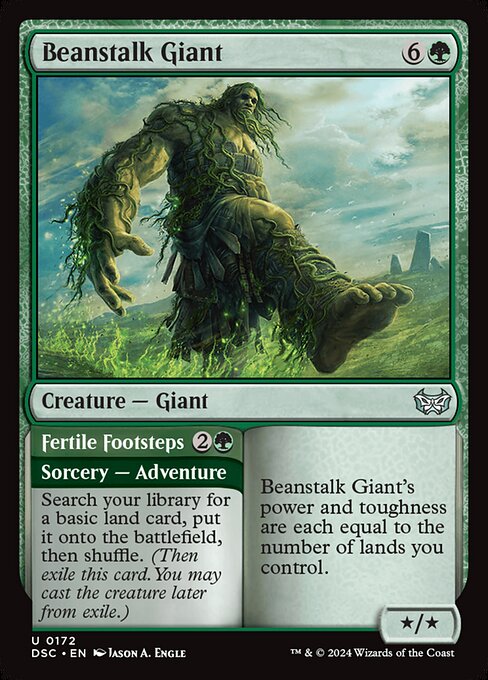 and Rosethorn Acolyte
and Rosethorn Acolyte will help you ramp (with the Seasonal Ritual
will help you ramp (with the Seasonal Ritual half helping you trigger Adamant, if needed). Your early game will lean pretty heavily on blue’s access to counterspells, so you may want to pick up some cheap defenders like Crashing Drawbridge
half helping you trigger Adamant, if needed). Your early game will lean pretty heavily on blue’s access to counterspells, so you may want to pick up some cheap defenders like Crashing Drawbridge or Wishful Merfolk
or Wishful Merfolk to stall the ground.
to stall the ground.
FINAL NOTE: ARTIFACTS
With as much emphasis as we’ve placed on utilizing a single color to its max potential and then splashing for support or the synergies within two different colors, don’t overlook artifacts. Enchanted Carriage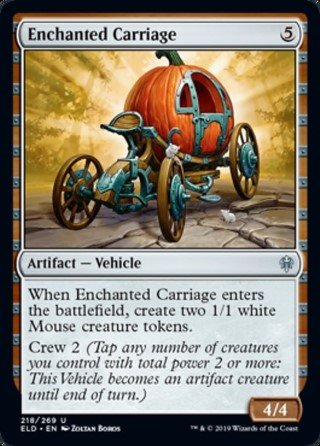 gets over the 4/4 body threshold we talked about in the beginning, Heraldric Banner can pump all of your creatures of one color and ramp you, Locthwain Gargoyle
gets over the 4/4 body threshold we talked about in the beginning, Heraldric Banner can pump all of your creatures of one color and ramp you, Locthwain Gargoyle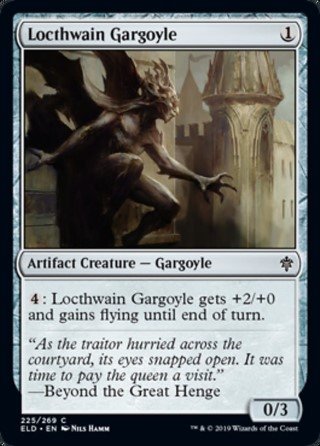 can profitably block half the flyers in the set (and trade with almost all of them). Signpost Scarecrow
can profitably block half the flyers in the set (and trade with almost all of them). Signpost Scarecrow , Crashing Drawbridge
, Crashing Drawbridge , and Roving Keep
, and Roving Keep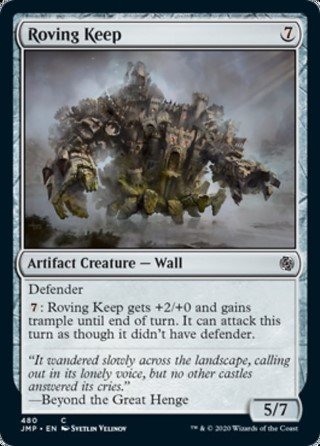 block absurdly well on the ground, Prophet of the Peak
block absurdly well on the ground, Prophet of the Peak can be a good late-game play to filter away your lands, and Spinning Wheel
can be a good late-game play to filter away your lands, and Spinning Wheel ramps you or keeps your opponent’s biggest threat tapped down. Finally, Weapon Rack
ramps you or keeps your opponent’s biggest threat tapped down. Finally, Weapon Rack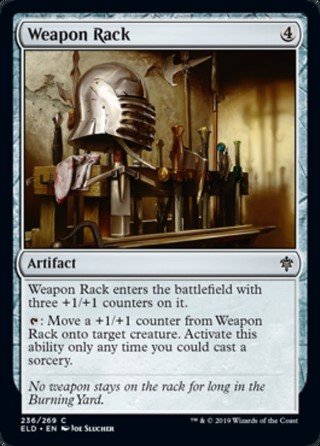 can make one of your creatures bigger each turn, which is a big deal with flyers, or if you want to go for maximum spice, you can use Brint to Life to turn it into a 7/7.
can make one of your creatures bigger each turn, which is a big deal with flyers, or if you want to go for maximum spice, you can use Brint to Life to turn it into a 7/7.
Eldraine looks like a massively deep set to play, but we at the C&C Power Hour are looking forward to it. Comment below with some cool synergies you’ve found or how your prerelease went, or stop by our livestreams! We stream Magic every Sunday at 4 pm or Wednesday at 8 pm Eastern at twitch.tv/cncpowerhour and would love to hear your thoughts. And, if you join us for Sunday, September 29, we will be building a prerelease pool live on stream and then playing it against our other players’ sealed pools. Thanks for reading!
About cncpowerhour:
The C&C Power Hour started as a joke between two friends at work, and grew to a ridiculously involved paper Magic: The Gathering stream. Every Sunday at 4:00 pm Eastern, we stream various limited formats or Commander on Twitch! We also occasionally stream video games and MTG Arena throughout the week when time allows.





sounds like FUN!!!